Lion850
National Hazard
   
Posts: 514
Registered: 7-10-2019
Location: Australia
Member Is Offline
Mood: Great
|
|
Report on making Indium Iodide
UPDATE added at the end.
I tried to make Indium iii Iodide InI3 with partial success. And some surprises (refer to http://orgsyn.org/Content/pdfs/procedures/V79P0059.pdf for background).
First I tried reacting In and I2 in dichloromethane:
- 5g In flakes and 10g I2 in 100ml DCM in a small beaker.
- Stir and heat, but just to warm to touch - the DCM did not boil. No I2 boiled off as far as I could see (and smell).
- After some 90 minutes the initial black color with purple foam changed to milky yellow.
- Added 5g I2 and top up the DCM to 100ml again and keep going
- After another 70 minutes the color again became milky yellow. At this point about 60ml DCM left.
- Filter solution, yellow filtrate. No precipitate. Notices that just about all of the 5g Indium was consumed which was correct.
- Boiled down the yellow filtrate to some 10ml. Still no ppt or crystals not even when cooled to room temp (30 deg C).
- Transfer to 200mm watch glass on steam bath. Became concentrated, but only to a point transferred the now black powder with some yellow specs still
moist to a vial. 10g. Noticed the stuff is very hygroscopic, every grain a spilled quickly became a drop. Probably not helping was the fact that there
was a torrential thunder storm from nowhere and my shed floor flooded with water at the same time I was trying to dry the iodide.
Overnight I decided to give it another go in Xylene, because the fact that I got no ppt did not seem correct (refer the article linked to at the start
of the post).
- 5g In flakes and 10g I2 in 200ml Xylene in a 500ml beaker
- Stir and heat, but not to reflux - just very hot.
- After an hour the solution was still dark but not purple any more. I increased the heat until the xylene was starting to boil and there was not
ofgassing of iodine. I then added another 5g of I2 and 2g of In flakes and continued.
- After some 30 minutes I kept the xylene at boiling, refluxing by condensing on the round bottom flask.
- After another hour the solution was still dark, but more transparent. There was hints of very dark red when the solution splashed up on the sides of
the beaker, and I could see what appeared to be a cloud of powder swirling around.
- I stopped stirring and heating and filtered the near-boiling solution. Yellow crystals covered the funnel outlet. The filtrate was very dark in
color. There was unreacted Indium left in the reaction beaker, as well as some sludge with a hint of red. The stir bar had a definite red coating.
- I boiled the filtrate down to 50ml and then put the small beaker in ice water for some 15 minutes. I then decanted the black liquid and was left
with a yellow ppt in the beaker. This was washed twice with xylene and then squeezed between 2 sheets of filter paper which in turn was surrounded by
sheets of absorbing paper towel. The filter paper was then placed directly onto a slightly warm hot plate for a while.
- The result was 5g of fine but still damp (with xyline I assume) yellow powder which I am reasonably sure is InI3. I did not want to try and dry it
further as I do not have the equipment to exclude moisture, pull a vacuum, and so on. I await to see if this powder keeps the color or whether it
eventually will darken like the alimunium iodide did.
I added a bit of water to the residue left in the original reaction beaker and as I thought may happen I got a red solution! The red color being quite
similar to what Poormans Chemist got on his YouTube video when he tried to directly combine InI3 and In.
I boiled down the dark filtrate until a black residue remained. The black solid melts if the beaker is heated more, and solidifies again when the heat
is removed. This stuff is VERY hygroscopic. It basically gets wet and dissolves in the water it attracts as you look at it. I did not check the weight
as it was just too wet, but it seemed to be more that the yellow ppt. I dissolved it in some water, obtaining a red solution, which I placed in a vial
until I can try to dry it one day.
I still have the 10g black residue from when I first tried with DCM; I will check if this also gives a red solution.
So the first interesting thing is that the reactions proceeds quite different in xylene compared to in DCM. In DCM the solution became yellow and the
reaction seemed more complete but it seems the InI3 in yellow form is so soluble in DCM it is difficult to get it out - at least when trying in the
open air. Maybe it started to absorb moisture even as the last of the DCM was boiling off.
In xylene the yellow ppt was expected but what is the black stuff that stayed in solution until the last of the xylene was boiled away? Is it indium
(i) iodide InI of just another form of InI3? As you can see in the below photos I labelled the vial InI but now I am not so sure, as I read somewhere
that there is also a red form of InI3.
Any ideas and suggestions will be appreciated!
Updated 15 December: I saw that all 3 products I got, the black crystals from the attempt in DCM as well as the yellow ppt and dark
red recovered from boiling down the Xylene reaction filtrate gave similar looking red solutions in water. I then dissolved all 3 in water in a beaker,
and boiled this down in a crucible in my sand bath. The sand temperature stabilized at 270 deg C, not sure exactly how hot the crucible got but it
must eventually have been close.
The solution became more golden yellow as it decreased in volume. Eventually I was left with a very dark liquid almost black. This was the molten
iodide, no more steam was coming off. When the crucible was bumper the liquid sloshing around was red when in a very thin film on the sides of the
crucible.
I removed the crucible from the sand and the iodide almost immediately solidified into a black solid, that showed yellow when the surface was
scratched. I broke this up while still very hot with some difficulty and recovered 16g.
The grains of iodide that remained in the crucible was very hygroscopic and soon dissolved itself in a layer of water.
I am quite sure this is mainly Indium iii Iodide InI3. The melting point is in the correct range, red and yellow colors are correct, and one source
even reported that if melted the liquid is black. What does not go as expected it that it stays black when it solidifies, maybe because I cannot
exclude atmospheric moisture. Although as mentioned there is yellow under the surface.
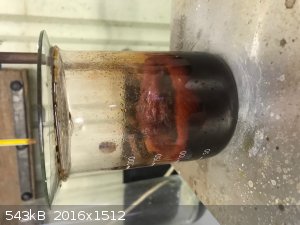 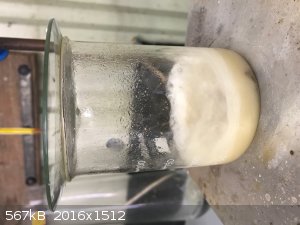 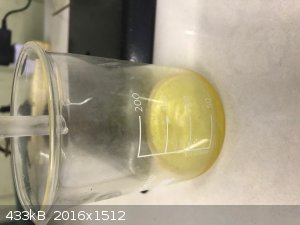 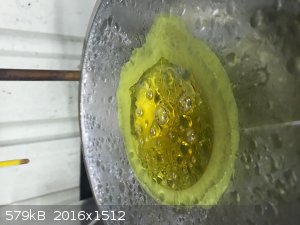 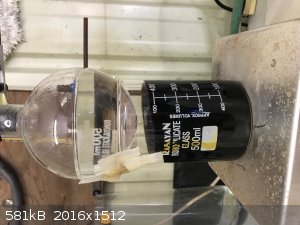 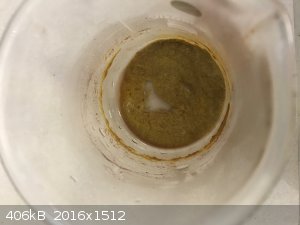 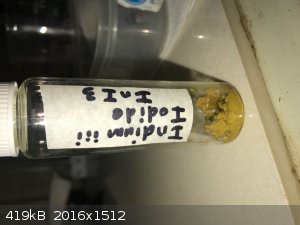 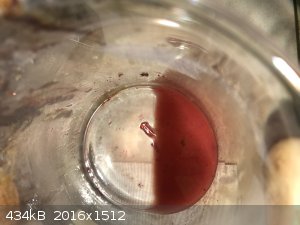 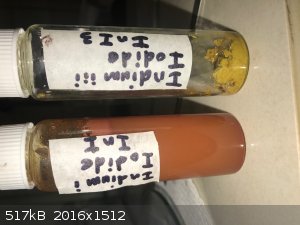
[Edited on 15-12-2019 by Lion850]
|
|
|
Tsjerk
International Hazard
    
Posts: 3022
Registered: 20-4-2005
Location: Netherlands
Member Is Offline
Mood: Mood
|
|
You should get yourself a drying tube you could place on one of those roundbottoms... DCM could be evaporated of through some CaCl2...
|
|
|
Σldritch
Hazard to Others
  
Posts: 309
Registered: 22-3-2016
Member Is Offline
Mood: No Mood
|
|
Xylene sounds like a terrible choice of solvent. You are making a heavier equivalent of anhydrous Aluminium Chloride and mixing it with a very
activated arene and a halogen. While probably not as aggresive as thier lighter equivalents i am sure you are losing a bunch of Iodine by
electrophilic halogenation of xylene.
|
|
|
unionised
International Hazard
    
Posts: 5104
Registered: 1-11-2003
Location: UK
Member Is Offline
Mood: No Mood
|
|
Quote: Originally posted by Σldritch  | | Xylene sounds like a terrible choice of solvent. You are making a heavier equivalent of anhydrous Aluminium Chloride and mixing it with a very
activated arene and a halogen. While probably not as aggresive as thier lighter equivalents i am sure you are losing a bunch of Iodine by
electrophilic halogenation of xylene. |
Good luck trying to iodinate aromatics that way.
However it's fair to assume that friedel crafts methyl exchange is going to happen which will give you a mess as teh solvent.
|
|
|
Lion850
National Hazard
   
Posts: 514
Registered: 7-10-2019
Location: Australia
Member Is Offline
Mood: Great
|
|
Tsjerk - the reaction was happening in the beaker. The RBF with cold water is for the xylene fumes to condense against and drip down. Works quite well
with xylene, hardly any lost, but cant seal the beaker. However my reflux glassware is on the way!
Σldritch - apart from water, DCM, and Xylene which other solvents do you suggest for these type of Iodine reactions? The advantages of Xylene for me
is that it is locally available and offers a higher boiling point.
|
|
|
Tsjerk
International Hazard
    
Posts: 3022
Registered: 20-4-2005
Location: Netherlands
Member Is Offline
Mood: Mood
|
|
Quote: Originally posted by Lion850  | | Tsjerk - the reaction was happening in the beaker. The RBF with cold water is for the xylene fumes to condense against and drip down. Works quite well
with xylene, hardly any lost, but cant seal the beaker. However my reflux glassware is on the way! |
I know  I was proposing to do the reaction in the RBF you already have and doing
so with a drying tube on top of it. But the reflux glassware would be even better, that would allow you to do the reaction at elevated temperatures. I was proposing to do the reaction in the RBF you already have and doing
so with a drying tube on top of it. But the reflux glassware would be even better, that would allow you to do the reaction at elevated temperatures.
|
|
|